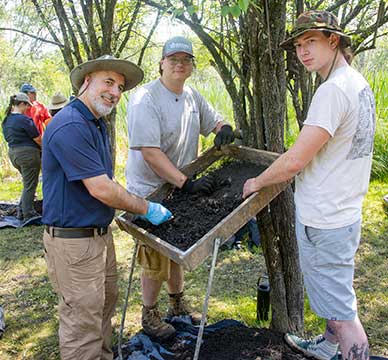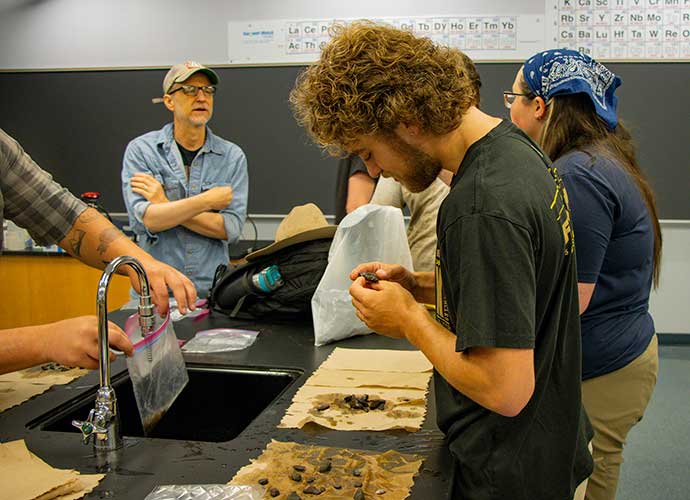Lasting Impact on Learning
Mastodon Project Will Have Long-Term Educational Impacts
Those SUNY Orange students who uncovered remains of an Ice Age mastodon during the Summer of 2025 enjoyed uniquely blended academic and life experiences that no previous SUNY Orange students have known in the College’s 75 years of existence.
But the impact of the mastodon discovery will continue to influence the College’s academic curriculum well beyond the Summer’s excavation, presenting learning opportunities for SUNY Orange students this Fall and into the future.
 For example, instructor Anthony Soricelli explains that students in his Earth science,
and physical and historical geology courses, will benefit from this project. Knowledge
gained from soil borings taken from areas in and around the skeleton will greatly
enhance the understanding of the geology of a region that once was home to long-extinct
mastodons and other species.
For example, instructor Anthony Soricelli explains that students in his Earth science,
and physical and historical geology courses, will benefit from this project. Knowledge
gained from soil borings taken from areas in and around the skeleton will greatly
enhance the understanding of the geology of a region that once was home to long-extinct
mastodons and other species.
“The geology piece is important to tell the story of how this animal died. If we understand the geology of the area, it gives us the clues we need to possibly determine the circumstances around its death,” Soricelli said. “But, more importantly, I can now bring relevant, local and fresh content to our students because of the College’s role in excavating this particular mastodon. The long-term impact upon my curriculum and teaching is exciting.”
During one rainy day when the team couldn’t be at the dig site, the students and professors were cleaning and cataloging a sizable batch of small, unidentified skeletal fragments, rocks and artifacts from the site. Off to the side, Soricelli was conducting an experiment in which he applied hydrochloric acid to a soil sample. The immediate fizzing and bubbling indicated the presence of calcium carbonate minerals. The chemical reaction occurs when acid contacts carbonate compounds, releasing carbon dioxide gas and creating the effervescence.
The positive test reveals that these sediments were likely deposited in a lake environment, where calcium carbonate forms through deposition in water by precipitation and through the action of aquatic organisms including the accumulation of shells and skeletal remains. Such carbonate-rich soils typically develop in alkaline, freshwater lake systems.
More importantly, I can now bring relevant, local and fresh content to our students because of the College’s role in excavating this particular mastodon. The long-term impact upon my curriculum and teaching is exciting. ”
Soil chemistry provides crucial evidence for archaeologists about the ancient environment where the mastodon lived and died. The presence of lake sediments suggests the mastodon inhabited a landscape with permanent water sources, wetland vegetation, and the kind of marshy, nutrient-rich ecosystem that these massive herbivores preferred. Understanding that this area was once a lakeside environment helps researchers reconstruct not only the mastodon's habitat but also the broader Late Pleistocene climate conditions and ecological relationships that existed thousands of years ago.
 For Harris, the first-hand experience of leading such an excavation and the ability
to bring those experiences to his students in coming semesters is powerful.
For Harris, the first-hand experience of leading such an excavation and the ability
to bring those experiences to his students in coming semesters is powerful.
“We have said this was a once-in-a-lifetime opportunity for our students, the same can be said for Anthony and I. Few faculty are presented with an opportunity like this. We were tremendously fortunate to be involved and we appreciate the College’s support in making this happen,” Harris added. “But the real winners are our students, both those in the field experience this summer as well as those who we’ll be teaching during the upcoming year.
“With photos, videos, soil samples and bone fragments, we’ll be able to give future students, who are sitting in our classrooms, a sense of what it was like to be at the dig site. But more importantly, we’ll be able to convey the lessons we learned from actually excavating this magnificent animal.”

